During a sun-soaked weekend getaway in Cebu last summer, I stumbled upon this incredible dish at a small carinderia tucked away in the bustling streets of Carbon Market. The aroma of garlic and vinegar drew me in, but it was the sight of these gloriously crispy ribs that made me stop in my tracks.
The owner, Manang Rosa, beamed with pride as she explained that this was Loslos - a treasured Visayan dish that transforms ordinary baby back ribs into something extraordinary through a clever double-cooking method.
What caught my attention wasn't just the crunch (though it was absolutely magnificent), but how the meat remained so tender and flavorful inside its crispy coating. After three visits in two days - yes, it was that good - Manang Rosa finally shared her family's recipe with me.
Now I'm excited to share this hidden gem with you, adapting her traditional technique for the modern home kitchen while keeping all the flavors that made me fall in love with Loslos in the first place.
Jump to:
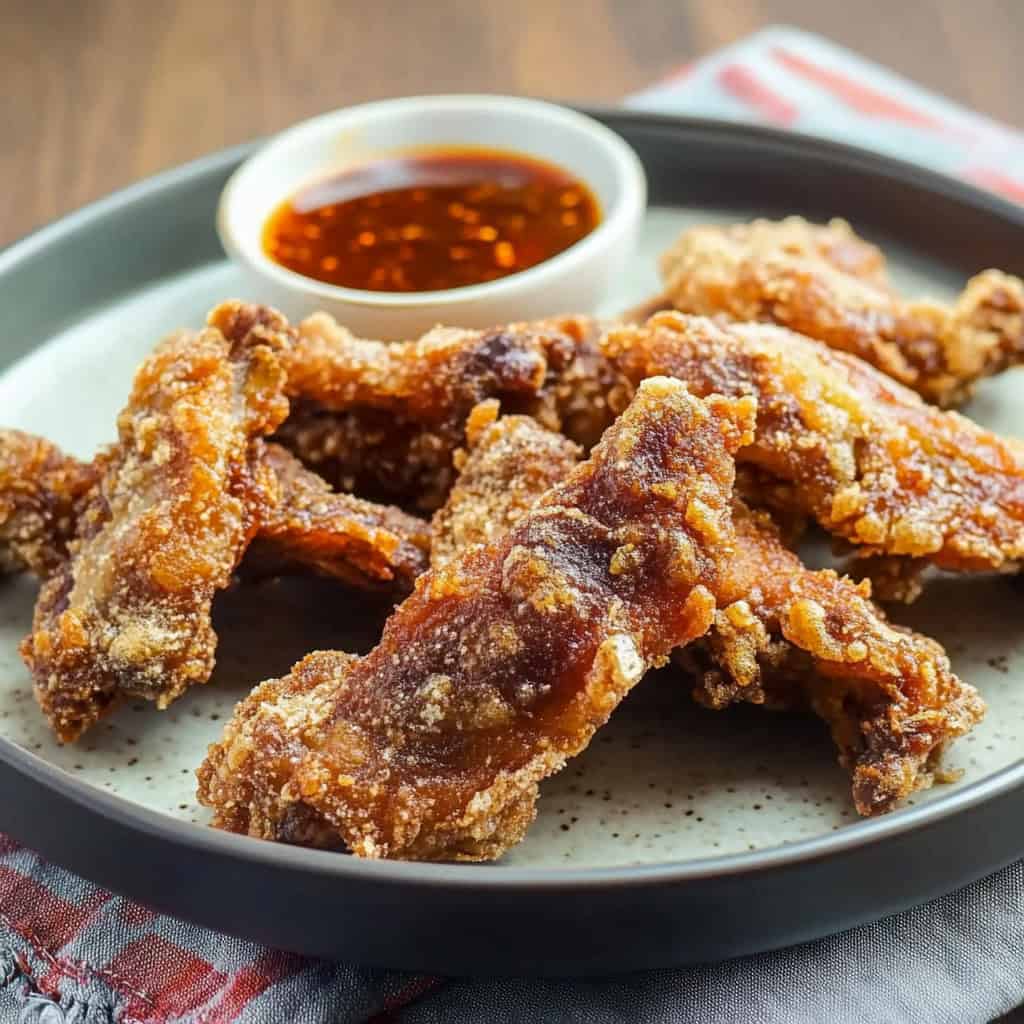
Why You'll Love This Recipe
- Double-cooking method ensures both tenderness and crispiness
- Makes an impressive centerpiece for celebrations (magandang panghanda)
- Perfect balance of garlic, soy, and vinegar flavors
- Can be partially prepared ahead for easier entertaining
- Versatile as both pulutan (appetizer) or ulam (main dish)
Ingredients
These ingredients create the perfect Loslos by combining Filipino adobo flavors with crispy fried perfection. The vinegar tenderizes the meat while soy sauce adds umami depth. Garlic, bay leaves, and peppercorns infuse the ribs with aromatic flavors during braising.
The simple flour coating creates a light, crispy shell that seals in moisture, while eggs act as the perfect binding agent. Canola oil's high smoke point ensures a golden-brown finish without burning.
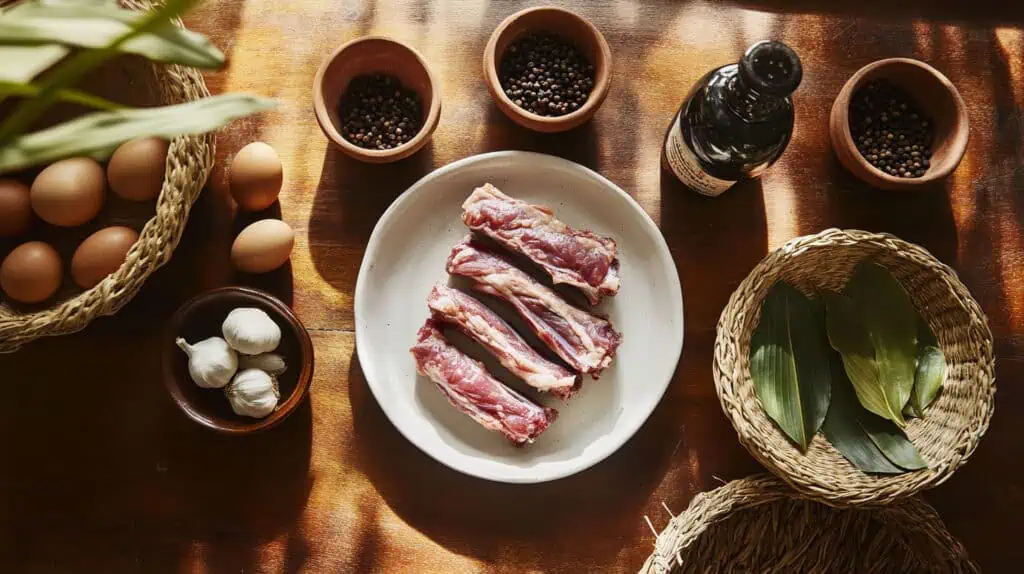
For Adobo Braising:
- 3 pounds baby back ribs, cut into individual pieces
- 1 cup vinegar
- ½ cup soy sauce
- 1 cup water
- 1 head garlic, minced
- 2 bay leaves
- 1 teaspoon whole peppercorns, cracked
For Coating:
- 1 cup all-purpose flour
- ½ teaspoon salt
- ¼ teaspoon ground black pepper
- 3 eggs
- Canola oil for deep-frying (enough for 2 inches of oil)
Equipment
- Large kawali or deep pot - For the adobo braising process; ensures even heat distribution for tender meat
- Deep heavy-bottomed pan or deep fryer - Maintains consistent oil temperature for perfect crispiness
- Metal tongs - Provides safe handling of hot ribs during the frying process
- Wire rack or strainer - Allows proper draining of excess oil for crispier results
- Meat thermometer - Ensures ribs are cooked to the perfect tenderness (145°F internal temperature)
- Paper towels - Absorbs excess oil after frying for a cleaner, less greasy finish
- 3 shallow dishes - Creates an efficient dredging station for the coating process
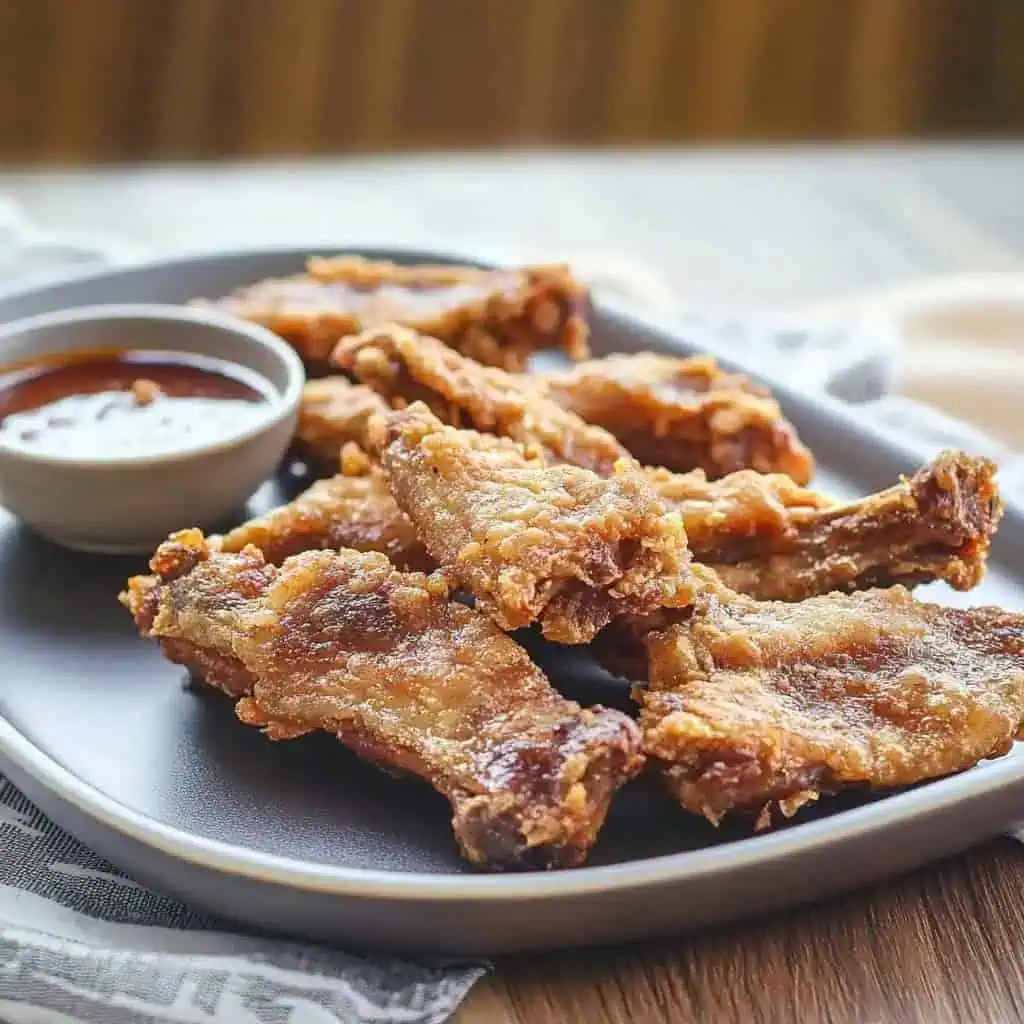
How To Make
- Pour enough oil into a deep, heavy pot, about 2 inches deep, and set aside for later frying.
- Mix vinegar, soy sauce, water, minced garlic, bay leaves, and cracked peppercorns in a large pot. Add the baby back ribs and bring to a boil over medium heat at 350°F. Do not stir for the first 5 minutes.
- Reduce heat to a gentle simmer at 320°F, cover the pot, and cook for 40-50 minutes until the meat is tender but still firmly attached to the bone.
- While the meat cooks, prepare your coating stations. Mix flour, salt, and pepper in a shallow dish. Beat eggs in a separate bowl until foamy. Set up another dish with the same flour mixture.
- Remove the ribs from the cooking liquid and let them cool completely to room temperature. Discard the cooking liquid.
- Heat your frying oil to 350°F. Take each cooled rib piece and coat it first in flour, then dip in beaten egg, and finally coat again in flour. Make sure each piece is evenly coated.
- When the oil is hot, carefully add 4-5 pieces of coated ribs. Fry for 4-5 minutes, turning occasionally, until golden brown and crispy.
- Remove the fried ribs with tongs and place on paper towels to drain excess oil. Continue frying the remaining pieces in batches.
- Let the oil return to temperature between batches to ensure even cooking. Don't overcrowd the pan.
- Serve immediately while hot and crispy with your favorite dipping sauce like soy sauce with calamansi or spiced vinegar.

Tips from Lola's Kitchen
- For mellowing the vinegar: Let the braising liquid boil uncovered first before stirring to reduce the sharpness and create a more balanced flavor.
- For extra crispiness: Double-coat the ribs in the flour mixture and make sure to press the coating firmly onto the meat before frying.
- For less mess: Use one hand for wet ingredients (eggs) and one for dry ingredients (flour) during the coating process to prevent your fingers from becoming coated and clumpy.
- For perfect texture: Make sure the braised ribs are completely cooled before coating and frying. This helps the coating adhere better and creates a superior crunch.
- For rich flavor: Don't rush the braising process. The slow simmering allows the vinegar and soy sauce to fully penetrate the meat.
- For uniform cooking: Cut ribs into similar-sized pieces to ensure they cook at the same rate during both braising and frying.
Substitutions
- Vinegar: Apple cider vinegar or white wine vinegar can replace regular white vinegar for a slightly different flavor profile.
- Soy sauce: Liquid aminos or coconut aminos work well for those looking for lower sodium or gluten-free options.
- Baby back ribs: Spare ribs can be substituted but will require an increased cooking time (approximately 15-20 minutes longer) during the braising phase.
- Canola oil: Peanut oil or vegetable oil are excellent alternatives for deep frying, offering different flavor notes and smoke points.
- All-purpose flour: Rice flour creates an even crispier coating for those who prefer extra crunch.
- Eggs: For an egg-free version, try a batter made from 1 cup water mixed with 2 tablespoons cornstarch as your wet component.
Troubleshooting
- Problem: Meat too tough
- Solution: Extend braising time by 10-15 minutes. The meat should be tender but still attached to the bone – it should not fall off completely.
- Problem: Coating falling off during frying
- Solution: Ensure meat is completely dry before coating. Pat with paper towels after cooling and before dredging in flour. Also, let the coated ribs rest for 5-10 minutes before frying to help the coating adhere better.
- Problem: Not crispy enough
- Solution: Check that oil temperature stays consistently at 350°F. Use a thermometer if possible. If the oil is too cool, the coating absorbs oil instead of crisping up.
- Problem: Oil splattering excessively
- Solution: Make sure the ribs are completely dry before coating and frying. Any moisture can cause dangerous oil splatter.
- Problem: Coating too thick or doughy
- Solution: Shake off excess flour between coating steps and press the coating gently onto the meat rather than caking it on.
Storage & Reheating
- Refrigerator Storage (Braised only): If you've braised the ribs but haven't fried them yet, they can be stored in an airtight container in the refrigerator for up to 3 days. This makes for excellent meal prep!
- Freezer Storage (Braised only): Braised, unfried ribs can be frozen for up to 2 months. Thaw completely in the refrigerator before coating and frying.
- Refrigerator Storage (Fully cooked): While best enjoyed fresh, fully cooked Loslos can be stored in an airtight container in the refrigerator for up to 2 days, though the coating will soften.
- Reheating Method 1: For the best results with fully cooked Loslos, reheat in an air fryer at 400°F for 3-4 minutes until hot and crispy again.
- Reheating Method 2: If you don't have an air fryer, place on a wire rack over a baking sheet and reheat in a 375°F oven for 7-10 minutes until heated through and re-crisped.
- Reheating Method 3: Avoid microwave reheating as it will make the coating soggy, but if necessary, use a microwave-safe plate lined with paper towels and heat for 1-2 minutes.

FAQ
Can I make this ahead for a party?
Yes! The perfect make-ahead strategy is to complete the braising process up to 2 days before, refrigerate the cooled ribs, then coat and fry just before serving.
Why do we need to boil without stirring for the first 5 minutes?
This helps develop proper adobo flavor and prevents the meat from breaking apart while the proteins begin to set in the braising liquid.
Can I use an air fryer instead of deep-frying?
Yes, you can! Spray the coated ribs with oil and air fry at 400°F for 8-10 minutes, turning halfway through. The texture will be slightly different but still delicious.
How do I know when the ribs are properly braised?
The meat should be tender when pierced with a fork, but should not be falling off the bone completely. A meat thermometer should read at least 145°F.
Can I reuse the braising liquid?
Yes, you can strain it and use it as a flavorful base for soups or as a marinade for other meats. Store in the refrigerator for up to 3 days.
What's the best vinegar to use for authentic flavor?
Traditionally, Filipino cane vinegar (sukang iloco) gives the most authentic flavor, but white vinegar or apple cider vinegar work well too.
Is there a way to make this dish less oily?
Using proper draining techniques with paper towels after frying helps. Alternatively, the air fryer method mentioned above significantly reduces oil content.
How do I cut the ribs into individual pieces?
Ask your butcher to cut them for you, or use a sharp chef's knife to carefully cut between the bones when the meat is raw.
Related
Looking for other recipes like this? Try these:
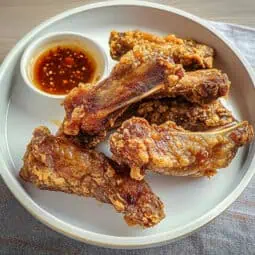
Loslos (Filipino Crispy Fried Baby Back Ribs)
Equipment
- Large kawali or deep pot (for adobo cooking) allows even heat distribution
- Deep heavy-bottomed pan or deep fryer (for frying) maintains oil temperature
- Metal tongs safe handling of hot food
- Wire rack or strainer (salaan) proper draining
- Meat thermometer ensures proper cooking
- Paper towels absorbs excess oil
- 3 shallow dishes (for dredging station)
Ingredients
For Adobo Braising:
- 3 pounds baby back ribs babyback na ribs, cut into individual pieces
- 1 cup suka vinegar
- ½ cup toyo soy sauce
- 1 cup tubig water
- 1 head bawang garlic, minced
- 2 dahon ng laurel bay leaves
- 1 teaspoon pamintang buo whole peppercorns, cracked
For Coating:
- 1 cup arina all-purpose flour
- ½ teaspoon asin salt
- ¼ teaspoon paminta ground black pepper
- 3 itlog eggs
- Canola oil for deep-frying
Instructions
- Pour enough oil into a deep, heavy pot, about 2 inches deep, and set aside for later frying.
- Mix vinegar, soy sauce, water, minced garlic, bay leaves, and cracked peppercorns in a large pot. Add the baby back ribs and bring to a boil over medium heat at 180°C/350°F. Do not stir for the first 5 minutes.
- Reduce heat to a gentle simmer at 160°C/320°F, cover the pot, and cook for 40-50 minutes until the meat is tender but still firmly attached to the bone.
- While the meat cooks, prepare your coating stations. Mix flour, salt, and pepper in a shallow dish. Beat eggs in a separate bowl until foamy. Set up another dish with the same flour mixture.
- Remove the ribs from the cooking liquid and let them cool completely to room temperature. Discard the cooking liquid.
- Heat your frying oil to 180°C/350°F. Take each cooled rib piece and coat it first in flour, then dip in beaten egg, and finally coat again in flour. Make sure each piece is evenly coated.
- When the oil is hot, carefully add 4-5 pieces of coated ribs. Fry for 4-5 minutes, turning occasionally, until golden brown and crispy.
- Remove the fried ribs with tongs and place on paper towels to drain excess oil. Continue frying the remaining pieces in batches.
- Let the oil return to temperature between batches to ensure even cooking. Don't overcrowd the pan.
- Serve immediately while hot and crispy with your favorite dipping sauce like toyomansi or spiced vinegar.
Tips from Lola's Kitchen
- Para hindi maanghang ang suka (To mellow the vinegar): Let it boil uncovered first before stirring
- Para malutong (For extra crispiness): Double-coat in flour mixture
- Para hindi makalat (For less mess): Use one hand for wet ingredients and one for dry
- Para hindi malambot (To maintain crispiness): Serve immediately
Nutrition
The Story Behind Loslos
Deep in the heart of the Visayas, particularly in the vibrant culinary landscape of Cebu, Loslos stands as a testament to Filipino ingenuity in transforming simple ingredients into extraordinary dishes. This unique preparation method, which combines the complex flavors of adobo with the satisfying crunch of deep-fried meat, emerged from the resourceful kitchens of local households where preserving and reimagining leftover adobo became an art form.
The name "Loslos" itself carries cultural significance, derived from the Cebuano word that describes the process of coating or dredging food in flour before frying. This cooking technique, while seemingly straightforward, represents generations of culinary wisdom passed down through Filipino families, each adding their own subtle variations to the basic method.
What sets Loslos apart from other Filipino pork dishes is its ingenious two-stage cooking process. The initial adobo braising infuses the meat with the quintessential Filipino flavor profile of garlic, vinegar, and soy sauce, while the subsequent flour-coating and deep-frying create a captivating textural contrast that has made this dish a staple at Filipino celebrations and gatherings.
In traditional Cebuano households, Loslos often makes its appearance during special occasions, particularly during fiestas where it serves as both a impressive main course and a beloved pulutan (appetizer) paired with ice-cold beer. The dish exemplifies the Filipino tradition of transforming everyday ingredients into celebration-worthy fare, showcasing the resourcefulness and creativity inherent in Filipino cuisine.
Modern iterations of Loslos have found their way into contemporary Filipino restaurants, where chefs are exploring new variations while maintaining the dish's authentic charm. From upscale establishments in Cebu City to humble carinderias in local markets, Loslos continues to captivate diners with its perfect balance of familiar adobo flavors and unexpected crispiness, proving that traditional Filipino recipes can evolve while preserving their cultural essence.
Today, this once-regional specialty has begun gaining recognition beyond the Visayas, earning its place in the broader tapestry of Filipino cuisine. As more food enthusiasts discover the unique appeal of Loslos, it serves as a delicious reminder of the depth and diversity of Philippine culinary heritage, one crispy, flavorful bite at a time.
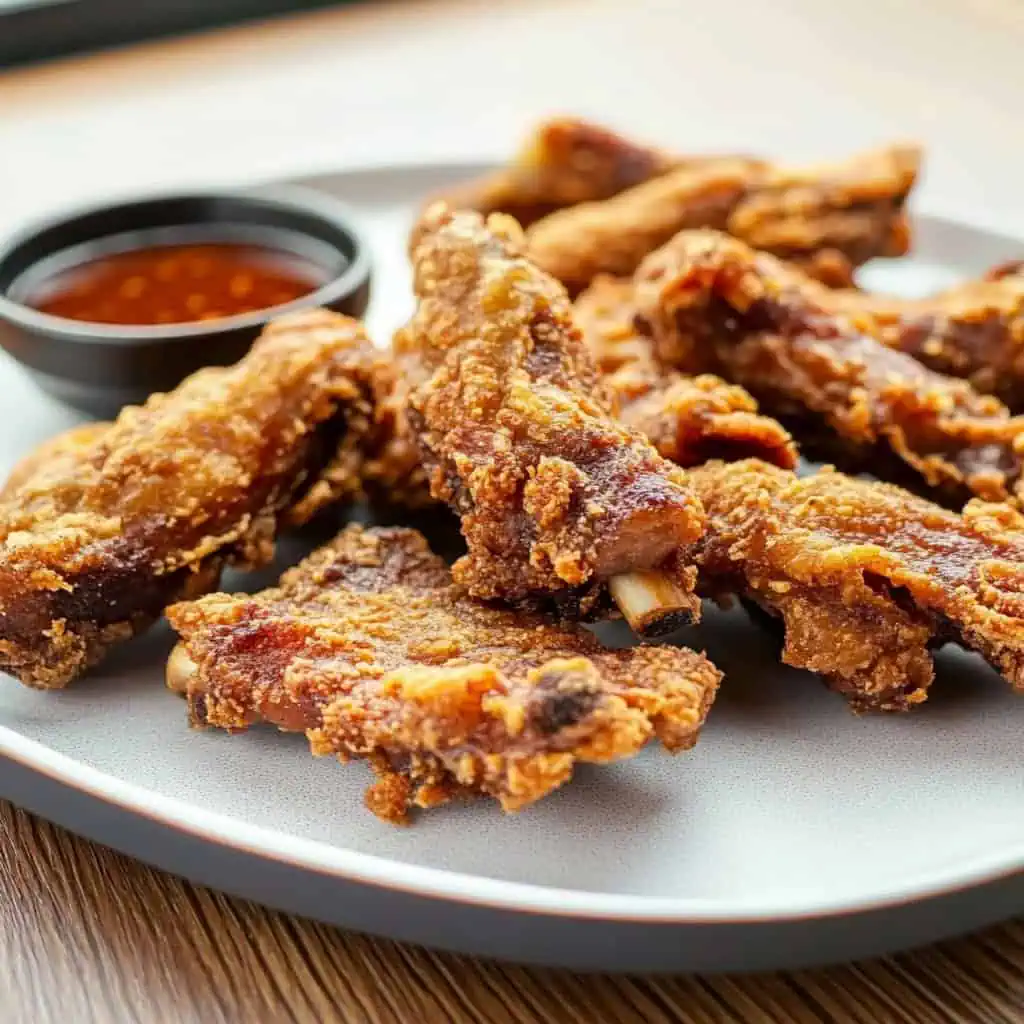









Comments
No Comments